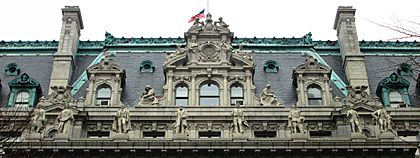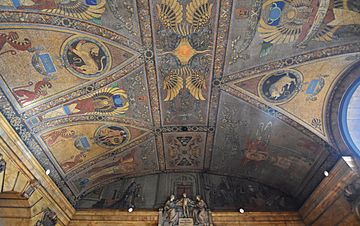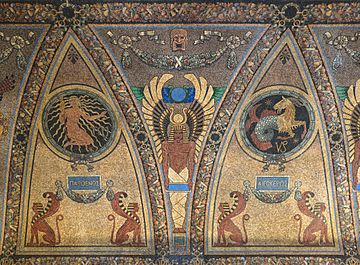Surrogate's Courthouse facts for kids
|
Surrogate's Court
|
|
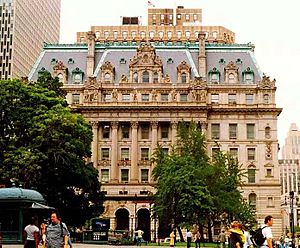
South facade in 2012
|
|
| Location | 31 Chambers Street Manhattan, New York City |
|---|---|
| Built | 1899-1907 |
| Architect | John R. Thomas; Horgan & Slattery |
| Architectural style | Beaux Arts |
| NRHP reference No. | 72000888 |
Quick facts for kids Significant dates |
|
| Added to NRHP | January 29, 1972 |
| Designated NHL | December 22, 1977 |
The Surrogate's Courthouse (also the Hall of Records and 31 Chambers Street) is a historic building at the northwest corner of Chambers and Centre Streets in Civic Center, Manhattan, New York City. Completed in 1907, the building was designed in the Beaux Arts style by John Rochester Thomas, as well as Arthur J. Horgan and Vincent J. Slattery. It faces City Hall Park and Tweed Courthouse to the south, and the Manhattan Municipal Building to the east.
The Surrogate's Courthouse consists of a seven-story, steel-framed structure with a granite facade and elaborate marble interiors. It was designed to be fireproof in order to safely house the city's paper records. The exterior contains fifty-four sculptures by prize-winning artists, as well as a three-story Corinthian-style colonnade on Chambers and Reade Streets. The building houses the city's Municipal Archives in the basement, and courtrooms for the Surrogate's Court for New York County on the fifth floor.
The Hall of Records building had been planned since the late 19th century to replace an outdated building in City Hall Park, and plans for the current building were approved in 1897. Construction took place between 1899 and 1907, having experienced several delays because of controversies over funding, sculptures, and Horgan and Slattery's involvement after Thomas's 1901 death. The building was renamed the Surrogate's Courthouse in 1962, and over the years, has undergone few alterations. The Surrogate's Courthouse is listed on the National Register of Historic Places as a National Historic Landmark, and its facade and interior are both New York City designated landmarks.
Site
The Surrogate's Courthouse is in the Civic Center neighborhood of Manhattan, just north of City Hall Park. It occupies an entire city block bounded by Chambers Street to the south, Centre Street to the east, Reade Street to the north, and Elk Street to the west. Other nearby buildings and locations include 49 Chambers and 280 Broadway to the west; the Ted Weiss Federal Building and African Burial Ground National Monument to the northwest; the Thurgood Marshall United States Courthouse to the northeast; the Manhattan Municipal Building to the east; and the Tweed Courthouse and New York City Hall to the southwest, within City Hall Park.
The ground slopes downward from north to south; the original ground elevation was below Reade Street and close to sea level. The surrounding area contains evidence of the interments of individuals, mostly of African descent, but the foundations of the Surrogate's Courthouse may have destroyed any remnants of corpses on the site. In the 18th and early 19th centuries, the Surrogate's Courthouse site was on a hill called "Pot Baker's" or "Potter's Hill", so named because several families in the pottery industry lived or worked nearby. Also at the site was a stone reservoir maintained by the Manhattan Company from 1799 until 1842, when the Croton Aqueduct opened. In the mid-19th century, the site contained small loft buildings. Prior to the completion of Elk Street in 1901, the site was part of a larger city block bounded by Broadway to the west, and by Chambers, Centre, and Reade Streets.
Design
The Surrogate's Courthouse was designed in the Beaux-Arts style. The general design was created by John Rochester Thomas, as well as by Arthur J. Horgan and Vincent J. Slattery. After Thomas's 1901 death, the design was completed by Horgan and Slattery, whose relatively unknown firm had connections to the politically powerful Tammany Hall organization of the time. The design largely conforms to Thomas's original plans, though Horgan and Slattery were largely responsible for the sculptural ornamentation. Fay Kellogg helped design or prepare plans for the Hall of Records, and designed the prominent double staircase in the building's lobby. The design has undergone relatively few alterations since its completion in 1907.
The Surrogate's Courthouse's seven-story granite facade wraps around the building's structural frame, while the interiors are elaborately designed in marble. The building was designed to be fireproof, in order to safely house the city's paper records. The interior spaces are popular with film and television production companies and have been used in many commercials, TV series, and movies. In addition to housing the Surrogate's Court for New York County, the building contains the New York City Municipal Archives and the New York City Department of Records and Information Services (DORIS)'s City Hall Library, as well as the New York City Department of Cultural Affairs.
Facade
The facade of the Surrogate's Courthouse consists mostly of granite from Hallowell, Maine, with ashlar masonry. It is split vertically into a two-story rusticated base, a three-story midsection, a sixth story, and a seventh story in a mansard roof. The northern and southern elevations are split vertically into thirteen bays, each of which generally has one window opening per floor, while the western and eastern elevations are split into eleven bays.
The central portion of the southern (Chambers Street) elevation contains three double-height arched doorways, each of which contains a pair of doors and a window with bronze grilles. The doorways are flanked by granite columns, each cast from a single granite slab and topped by modified composite capitals. This entrance was wainscoted entirely with Siena marble at the building's completion. There are side entrances in the center bay of the western elevation on Elk Street, from which there is a small flight of steps, and in the center bay of the eastern elevation on Centre Street. The Reade Street elevation contains a wheelchair-accessible entrance.
On the northern and southern elevations, the central five bays of the third through fifth stories are flanked by a projecting Corinthian style colonnade with four single columns between two paired columns at either end. On all four elevations, the outermost bays are designed with window openings on the second, third, fifth, and sixth stories, and sculptures around porthole windows on the fourth story. The remaining six bays on the north and south, and the center nine bays on the west and east, are slightly recessed behind the end bays, and each story contains different designs of windows. An entablature and a cornice runs above the fifth story, and another cornice runs above the sixth story. The seventh story contains dormer windows with carved hoods, projecting from the mansard roof in all except the end bays.
Sculptures
The exterior features fifty-four sculptures by Philip Martiny and Henry Kirke Bush-Brown. Martiny was hired for the main sculptural groups, while Bush-Brown designed the smaller sculptures. Like the rest of the facade, the statues were carved from Hallowell granite.
On Chambers and Centre Streets, Martiny carved 24 standing figures at the sixth floor, under the cornice. These sculptures depict eminent figures from the city's past, including Peter Stuyvesant, DeWitt Clinton, David Pietersen De Vries, and mayors Caleb Heathcote, Abram Stevens Hewitt, Philip Hone, Cadwallader David Colden, and James Duane. Martiny also designed the well as groups of sculptures flanking the Chambers and Centre Street entrances. Three sculptures flank the Chambers Street entrance, while two originally flanked the Centre Street entrance. The latter, depicting Justice and Authority, was removed in 1959 and relocated to the New York County Courthouse.
On all four sides, Bush-Brown designed groups of allegorical figures for the roof. The figures were arranged in standing, sitting, or reclining postures. At the base of the central dormer on Chambers Street are figures depicting Heritage and Maternity. Above the central Chambers Street dormer is a clock with a dial measuring 4 feet (1.2 m) across; this clock is flanked by figures of Poetry and Philosophy and topped by four cherubs and two caryatids. A similar dormer at the center of Reade Street has figures depicting Instruction, Study, Law, and History. The central Centre Street dormer has figures of Inscription and Custody and the central dormer on the west side has Industry and Commerce.
Interior
Entrance vestibules
The rectangular entrance vestibule from Chambers Street contains rusticated yellow marble-clad walls. Just opposite the arched entryways is an arcade with decorative cartouches. Double doors made of mahogany are set within marble doorways at either end of the vestibule. The German sculptor Albert Weinert created two marble sculptural groups, one above each set of doorways; these depict the 1624 purchase of Manhattan Island and the 1898 creation of the City of Greater New York. The vestibule's elliptical ceiling contains mosaic murals and panels created by William de Leftwich Dodge. Of the four mosaic murals, three depict the probate process (in reference to the Surrogates' Court) and the other depicts the continuity of records. The ceiling's triangular mosaic panels depict Egyptian and Greek motifs along with zodiac signs. The mosaic tiles are largely colored red, green, and blue on dull gold. The vestibule also contains a bronze chandelier, ornamental bronze radiators, and a patterned marble floor.
Smaller entrance vestibules also exist on the west and east ends of the Surrogate's Courthouse; they are largely similar, except for the steps outside the west vestibule. Decorative bronze-and-glass enclosures frame the doorways, while there are mosaic lunettes over the two side doors from the vestibules. In the elliptical ceiling vaults of these vestibules, Dodge also designed mosaics set in glass. The mosaics are largely blue and gold, but have green and rose accents. The ceiling is divided into several panels with decorative elements such as garlands, urns, and acanthus scrolls.
Lobby and lower-story spaces
The entrance vestibules lead to the main lobby, a triple-story space whose design was inspired by that of the Palais Garnier, the opera house of the Paris Opera. The lobby uses yellow Siena marble throughout. Surrounding the lobby space on the first floor is an arched gallery with rusticated piers, scrolled keystones, red marble roundels, and garlands linking the roundels and keystones. A decorative frieze runs above the first floor gallery. A marble double staircase with balustrade flanks the western entrance archway on the first floor, ascending two flights to an intermediate landing, where a single flight leads to the second floor. On the second floor is a colonnaded gallery containing engaged columns with Ionic-style capitals. The tops of the lobby walls contain decorative entablatures. The ceiling has a bronze elliptical arched vault reaching the height of the third floor. Within the arched vault is a gable-shaped skylight measuring 40 by 60 feet (12 by 18 m).
The hallways on the first floor contain marble walls and multicolored patterned marble floors. The passageways contain groin vaulted ceilings with chandeliers. There are recessed mahogany double-doors leading to the offices, and red marble roundels above each doorway. Service functions, such as fuse boxes, are contained within bronze boxes. The second-floor gallery's arches divide the gallery into bays. Within each bay, there are shallow domed ceilings supported on decorative pendentives, and a cornice runs beneath each dome. On the walls, there are arched openings with mahogany double doors. Above the double staircase in the lobby, a balustraded staircase rises from the second-floor gallery to the third floor, with an intermediate landing above the double stairway.
Upper stories
The third through fifth floors are largely similar in plan, and surround an interior light-court above the lobby. These floors are connected by a staircase similar in design to the one connecting the second and third floors. The floor surfaces of the third through fifth stories are made of mosaic tile and the walls consist of gray-veined marble panels. Each story contains different decorative designs on the frames surrounding the doorways and on the openings facing the light-court.
The two Surrogates' courtrooms on the fifth floor, planned as part of the building from the beginning, contain similar layouts with minor differences in decorative detail. The courtrooms have gilded, paneled plaster ceilings with decorative reliefs and ornate chandeliers. The north courtroom is finished in Santo Domingo mahogany and has four carved panels signifying wisdom, truth, civilization and degradation, as well as six repeating motifs and several portraits of surrogates. The south courtroom is finished in English oak, with French Renaissance style decorative elements. Overlooking each courtroom is a marble balcony, reached by staircases in the respective courtrooms. There are also ornately carved fireplaces, which contain marble mantelpieces lined with bronze surrounds made by Tiffany & Co.. The seventh floor and the attic housed the city's records on steel shelves until 2017.
Basement
The vaults of the Surrogate's Courthouse's basement extend underneath both Chambers and Reade Streets, descending 40 feet (12 m) under Chambers Street and 30 feet (9.1 m) under Reade Street. At opening, the Surrogate's Courthouse contained a small power plant in the basement, which provided power to the building and also served neighboring municipally-owned buildings.
The basement contains the municipal government's City Hall Library as well as the Municipal Archives. The library consists of two publicly accessible reading rooms as well as several storerooms beneath the main basement for the Municipal Archives. The collection contains over 400,000 publications, including 66,000 books and 285,000 newspapers, journals, magazines, and periodical clippings. The material in the collection totals over 200,000 cubic feet (5,700 m3).
History
In 1831, the original Hall of Records opened northeast of City Hall on the site of the "New Gaol", the old city jail, in present-day City Hall Park. The New-York Mirror described the original building as a Grecian-style structure with marble-columned porticoes on each side, as well as stucco walls, a copper roof, and masonry floors. In 1870, the original building was expanded by one story, and a "fireproof" roof was erected. The first Hall of Records became dilapidated over time, and as early as 1872, lawyers had objected to the rundown condition of the building. Despite its fireproof appearance, the first Hall of Records used wood extensively in its floors and roof. The first Hall of Records was razed in 1903 and a subway entrance to the New York City Subway's Brooklyn Bridge–City Hall/Chambers Street station was built there.
Planning and construction
Need and plans
By March 1896, a grand jury had reported that the old Hall of Records was "unsafe and susceptible to destruction by fire". Conditions in the old building were reported to have to be "repeatedly condemned" by the New York City Department of Health. In a November 1896 meeting of the New York City Board of Estimate, Ashbel P. Fitch, the New York City Comptroller, offered a resolution to create a committee and select a site for a new Hall of Records building. A coalition of lawyers, businesspersons, real estate developers, and property owners was created the next month to advocate for a new building. At the time, the city government preferred that new municipal buildings be erected in the area immediately outside City Hall Park, instead of inside the park, as the old Hall of Records had been.
The state legislature authorized the new Hall of Records building in early 1897, and the Board of Estimate recommended a site on the west side of Centre Street, between Reade and Chambers Streets. The site was approved in April 1897 despite the objection of Fitch, who believed that a site immediately to the north would be cheaper. The approval of the site also included an extension of Elm Street southward from Reade to Chambers Street, forming the site's western boundary; the street extension was completed in 1901.
Thomas was indirectly chosen as architect through the second of four architectural design competitions for the Manhattan Municipal Building, held between 1892 and 1894. Out of 134 plans submitted, six finalist designs were chosen in 1894. In February 1896, the Municipal Building Commission of New York City awarded Thomas the first prize in the design competition, which included his employment as architect of the municipal building. However, the municipal building for which Thomas had prepared plans had been canceled in 1894. Thomas was selected as architect upon the urging of then-mayor William Lafayette Strong. According to architecture critic Montgomery Schuyler, Strong had reminded the Board of Estimate that Thomas "deserved some consolation for a failure that had occurred by no fault of his own". Thomas presented his plans to the Board of Estimate in May 1897, and the plans were referred to a committee composed of Schuyler, architect William Robert Ware, and philanthropist Henry Gurdon Marquand. The Board of Estimate approved the plans and authorized bids for the building's construction in November 1897.
Start of construction
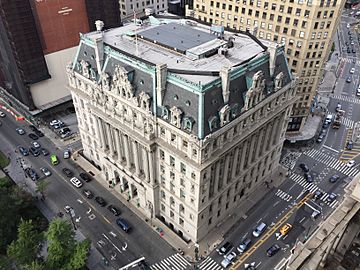
Thirteen companies submitted bids for granite in December 1897, and John Peirce won the contract to supply white Hallowell granite. The start of work was delayed due to difficulties in acquiring the plots for the building's site. Some of the old buildings on the site were sold in early 1898. However, other property owners resisted the seizure of their property through eminent domain. The resistance of one landowner—the Wendel family, which owned a myriad of Manhattan properties and had a policy to "never sell anything"—required the state legislature to pass a special act to obtain the small portion of the site owned by the Wendels. Lessees also objected to the fact that they would not be compensated for the unexpired terms of their leases. Further complicating the construction process, there were several unsuccessful competing schemes for the site, including proposals for the municipal building and a new county courthouse, both in 1900. As late as 1904, there existed plans to convert the then-nearly-complete building into one wing of a new county courthouse.
Work on the foundations started in early 1899, but was halted about ninety days afterward. The main reason was lack of funding; several bond authorizations for the building had been delayed for various reasons. Peirce filed a lawsuit in July 1898 to recover his payment, the State Supreme Court issued a mandamus to authorize a bond issue to pay Pierce, and the City Council passed a bill to that effect on August 3. The City Council adopted a resolution in a contentious vote the following week, authorizing the issuance of $2.1 million in bonds for the building's construction; the City Council president Randolph Guggenheimer was called to cast the deciding vote.
Meanwhile, the Tammany Hall-affiliated Robert Anderson Van Wyck won the 1897 mayoral election, and soon after his inauguration, accused the Strong administration of "extravagance" in its design. Ever since the election, Van Wyck had wanted to appoint as the project's architects Horgan and Slattery, who were friendly with the Tammany political machine. In 1899, the mayor hired the firm to conduct a report on possible ways to reduce the cost of the interior furnishings. The original interior cost was to be $2.5 million, but following Horgan and Slattery's recommendations, the interior appropriation was reduced by $1 million; the interior surfaces were to be made of cement rather than marble. The Board of Estimate received several bids for interior decoration in mid-1900, but rejected them all, because the Comptroller's office had received "a number of complaints" that Thomas had shown favoritism to certain contractors. Guggenheimer laid the ceremonial cornerstone of the building at a ceremony on April 13, 1901.
Change of architect and completion
Work had progressed slightly when Thomas died on August 28, 1901. Under pressure from Van Wyck, the Board of Estimate appointed Horgan and Slattery as the new architects two weeks later, prompting the Thomas estate to sue for damages. The New York Times criticized the change in plans as a "horganizing and slatterifying" of Thomas's original design. Comptroller Bird S. Coler protested against Horgan and Slattery's appointment, and Fitch refused to give Thomas's plans to Horgan and Slattery, because the firm would not be able to collect fees unless they had the plans. After Seth Low won the 1901 New York City mayoral election, he unsuccessfully attempted to cancel Horgan and Slattery's contract, but succeeded in limiting the number of changes made to Thomas's plan. By October 1902, a decision had been made to demolish the old Hall of Records, and at the end of the year, records were moved to a temporary site in the Morton Building on Nassau Street. Early in 1903, the Board of Estimate moved to approve Thomas's original plans for the interior of the new building.
Controversies also arose following Martiny's and Bush-Brown's selections as sculptors for the Hall of Records building. Critics stated that the two sculptors could not commission the sculptures to the desired specifications in a short enough time period, while the city's Municipal Art Commission objected that Horgan and Slattery had never presented them with general plans for the sculptures and decorative marble. Mayor Low upheld the sculptural contracts in June 1903, which were estimated to be worth $75,000. The statues were delivered in mid-1903, but not installed for several years, because the Municipal Art Commission refused to approve them until 1906.
Three city departments were scheduled to move into the new Hall of Records building in May 1904 upon the expiration of leases in these departments' present quarters. However, the building was not yet complete at the time, despite assurances made the previous year by Jacob A. Cantor, then the Manhattan borough president. In an attempt to speed up occupancy of the building, the installation of murals had been delayed. Further delays were announced in 1905, with the announcement that Horgan and Slattery would refurbish the not-yet-complete interior for $500,000. Upon inquiry from the Board of Estimate, the contractors made various excuses for the delays.
Use
Early to mid-20th century
The building saw its first occupants in December 1906. News outlets reported shortly afterward that some of the building's "marble" was made of plaster, although this was consistent with the construction contract calling for "plaster enrichment". This substitution was not the result of corruption, but instead due to the numerous changes in plans under the administrations of three mayors. Upon the building's completion, Horgan and Slattery claimed that the building's final cost was $5.063 million, while other estimates placed the cost as high as $10 million. In any case, despite the Hall of Records building's expense and the $90,000 annual maintenance cost, the New-York Tribune reported in 1907 that the building was already dirty and that some of the furnishings had been damaged to an extent described as "little short of criminal".
From the beginning, the Hall of Records contained space for New York City's departments of finance, taxes and assessments, and law, as well as the New York County Register, County Clerk, and Surrogate's Court. Other agencies and organizations occupied the building as well. The Vehicular Tunnel Commission was established in the Hall of Records in 1919, as was an employment bureau for soldiers.
The original elevators in the Hall of Records operated for several decades, and over the years, the number of elevators was cut from ten to six. Faults in the elevator system had resulted in several deaths, while elevator operators were reluctant to operate the Hall of Records' elevators. The city government spent several hundred thousand dollars to repair the faulty elevators during the 1930s and 1940s, and new elevators were installed in the building in 1953. Another modification was made to the eastern facade in 1959, when the statues flanking the Centre Street entrance were removed because of street-widening work and the expansion of the underlying subway station.
Late 20th century to present
The Hall of Records was renamed the Surrogate's Courthouse in 1962. The New York City Council adopted a resolution to rename the structure that October because most of the building's space was used by the court and related offices. During the mid-1960s, the government of New York City proposed a new Civic Center municipal building, which entailed destroying several surrounding buildings. The architects of the planned building had proposed the courthouse's eventual demolition because the plans called for the new building and City Hall to be the only structures in an expanded City Hall Park. The redevelopment plans were ultimately scrapped during the 1975 New York City fiscal crisis.
During a renovation of the Municipal Building in the 1970s, the Municipal Reference Center was moved to the Surrogate's Courthouse. The Department of Records and Information Services (DORIS) was founded in 1977, with its headquarters on the first floor of the Surrogate's Courthouse. DORIS combined the functions of the Municipal Reference Center with those of the Municipal Archives and Record Center, a separate agency. By the 21st century, the Surrogate's Courthouse no longer provided sufficient space for the city's records. In 2017, DORIS started moving the records to the New York State Archives, as well as to the Municipal Archives in the building's basement.
Between 2016 and 2020, Urbahn Architects renovated the lobby's skylight, which involved replacing several parts of the corroded steel frame as well as adding replicas of the original skylight's glass blocks. The skylight replacement project received the 2020 Lucy Moses Preservation Award from the New York Landmarks Conservancy.
Impact
Landmark designations
The exterior of the Surrogate's Courthouse was made a New York City designated landmark in 1966, while the interior was similarly designated in 1976. The building was placed on the National Register of Historic Places in 1972, and it was also designated a National Historic Landmark in 1977 for its architecture. The Surrogate's Courthouse building is also located within two historic districts. It is part of the African Burial Ground and the Commons Historic District, which was designated a city landmark district in 1993. The building is also part of the African Burial Ground Historic District, a National Historic Landmark District.
See also
 In Spanish: Edificio del Tribunal Testamentario de Nueva York para niños
In Spanish: Edificio del Tribunal Testamentario de Nueva York para niños


